Holme Sluice Fish Pass (2022)
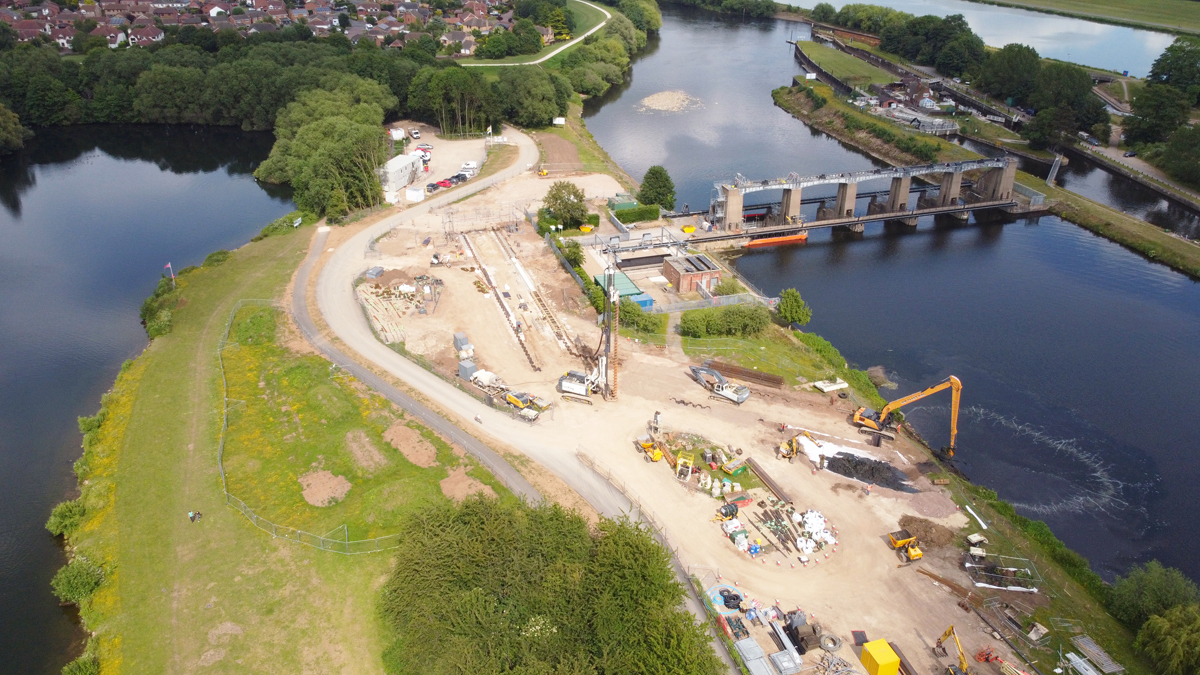
Holme Sluice Area (June 2022) - Courtesy of Environment Agency
During the 1950s the Holme Sluice Gates structure was constructed, diverting the River Trent from its original path around the Country Park through a newly excavated 80m wide cut channel. The gates are operated by the Environment Agency to maintain navigable river levels within the Nottingham area. At the side of the sluice gates is the Holme Canal Lock with a further adjacent water structure of the Holme Pierrepont canoe slalom course. All these structures create barriers for migratory fish in the River Trent.
Project scope
The conceived project is to construct a new fish passage around the sluice gates allowing bidirectional travel of all breeds of fish from salmon to coarse river fish. The channel specification is 215m in length, 6.5m wide and has a vertical depth from ground level to invert that varies from 4-6m. The flows within the channel will vary between 4.4m3/s and 4.9m3/s. To provide rest for the migrating fish, 20 pools will be created where the flows will drop to 1m3/s. These pools will also act as multiple hydraulic breaks to control the level of water within the channel due to the circa 3m head between upstream and downstream river levels.
As the sluice gates have to remain operational, the fish pass channel requires two bridges rated to 40t built on continuous flight auger (CFA) pile foundations to maintain access to that area.

Holme Sluice Area (January 2022) – Courtesy Environment agency
The channel will be protected at the intake via a single floating boom and the water isolated from the channel by a combination of removable stop logs and an automated radial gate system.
One key criterion of the project is to maintain working access at all times during construction to the sluice compound that will be encircled by the channel, allowing the use of a 40t crane in an emergency.
The design of the fish pass has been provided by the client’s designer, a joint venture of TEAM Van Oord, with Jackson Civil Engineering undertaking design elements for the temporary works and mechanical, electrical, instrumentation, control and automation elements.
The enabling works
The works are taking place within the park which remains open for public use, furthermore, the channel is to be built on the line of the existing park road, public footpath and areas of mature trees. Therefore, significant enabling works early in the project were needed to ensure the safety of the public.
The project started ion site in January 2022 with the removal of some 200 trees, approximately 200m of foliage hedgerow and the temporary diversion of the Public Right of Way (PRoW). Following on from the removal of the trees, construction started on the new 300m-long park road, built to HRA specification, and the new permanent PRoW. Once completed, the road and PRoW were put into use to allow the construction of the fish pass to be started.
The area also has significant below-ground services including high and low voltage cables, BT phone cables and numerous private water supplies, which all required diverting. The sequencing of these diversions through new duct systems installed as part of the road diversion were complex and had to be completed in stages to allow sheet piling works to commence. To allow all the services to cross the channel a temporary support structure has been installed until the permanent bridges are constructed and the services can be relocated through the bridge service duct system.
Jackson Civil Engineering have contracted with a local civils groundwork company (M2 Civils Ltd) to undertake the groundworks required throughout the project.
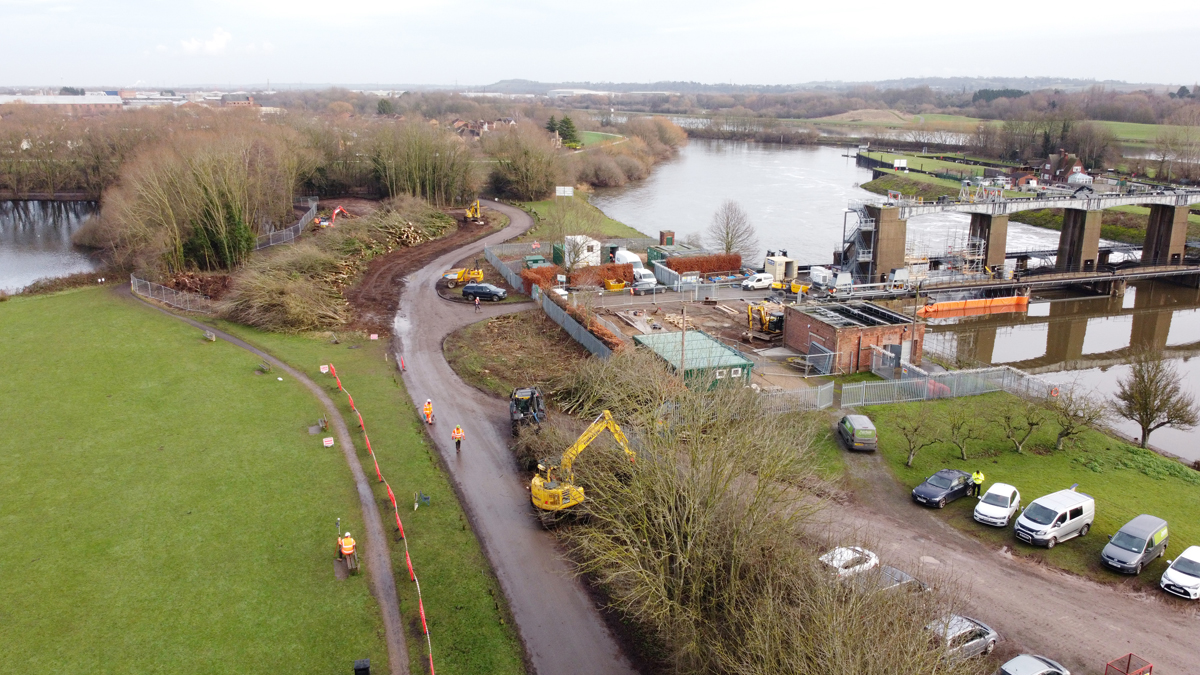
Holme sluice tree removal – Courtesy Environment Agency
The challenge of gaining access to the park
The park (originally an old gravel pit) is encircled by the old River Trent Loop. Access for vehicles is via a weak bridge rated to 40t and by foot on an adjacent footbridge. One major challenge of the project was how to transport the construction equipment needed into the park knowing that the piling rig would be in the region of 75t in weight.
The two existing bridges are 6.8m apart. Having discussed the issue with Jackson Civil Engineering’s temporary works supplier Mabey Hire Ltd, the solution put forward was to install a temporary bailey bridge between the two existing bridges that would be rated to 110t and span 6m.
Ground investigations showed hard mudstone at a depth of 9m suitable to take the loadings of the bridge and Jackson Civil Engineering’s temporary works designer SWECO was engaged to produce the bridge abutment design. In conjunction with Jackson Civil Engineering’s piling contractor and formwork reinforced concrete (FRC) contractor STAM Construction Ltd, the bridge foundations of 10 (No.) 10m universal column (UC) piles per abutment were driven into the ground using excavator mounted Movax vibration and percussion pile drivers with an 8m3 FRC concrete cap.

Temporary bridge – Courtesy Environment Agency
During the piling works, and due to the minimal distance from the piles to the existing bridge, both the vehicle and footbridge were monitored for vibration and movement via sensors and continuous engineering measurements. The results showed that during the piling works the vibration was no worse and, in some cases, less than that created by a car travelling across the bridge.
The bridge itself was installed using a push launch system due to the restrictions ruling out a one-piece crane lift installation. The bridge was built in sections and using the designed counterbalance weights was pushed across the abutment gaps before being lowered into place.
After the installation of the UC piles, reinforced concrete abutments and landing of the bridge, the local areas required using significant re-grading to bring the on and off ramps to the required level as the temporary bridge is some 800mm above current ground level.
The whole process from concept of idea through the surveys, design and construction to a full working bridge took around 6 months.
Holme Sluices Fish Pass: Supply chain – Key participants
- Main contractor: Jackson Civil Engineering
- Designer: TEAM Van Oord
- ECC project manager: Arcadis
- Mechanical design: KGAL Consulting Engineers Ltd
- Temporary works (bridge): Mabey Hire Ltd
- Temporary works (design): SWECO
- Piling works: Ivor King The Piling People
- Groundworks: M2 Civils
- Dredging: Red7 Inshore Diving
- Formwork reinforced concrete: STAM Construction Ltd
- Labour: AS Plant
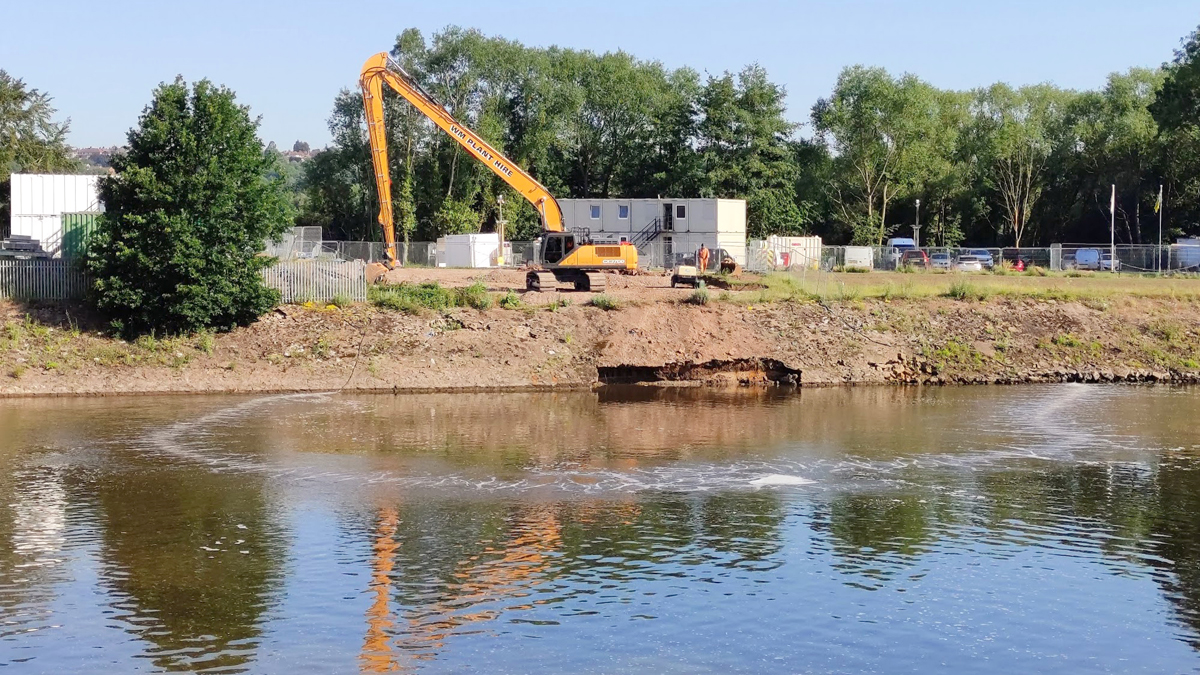
Dredging works downstream – Courtesy Jackson Civil Engineering
Piling works
Starting at the end of April 2022 and running through to July 2022, Ivor King The Piling People installed around 350 pairs of AZ36-700 sheet piles to create the cofferdam for the main channel works. The piles ranged from 8m to 11m in length. To aid in the installation of the sheet piles due to the geology of the site (as it sits on a mudstone stratum at approximately 7m below ground level), the full 400m circumference of the sheet piling cofferdam has been pre-augured. This allowed Ivor King to install 20-25 piles each piling day.
In addition to the sheet piles, Ivor King The Piling People installed 12 (No.) 13m-long, 800mm diameter, continuous flight auger (CFA) piles for the two permanent bridge abutments. Due to the non-standard sizing of the CFAs, the CFA auger required modification from a standard 750mm including modifications to the augur guide gate.
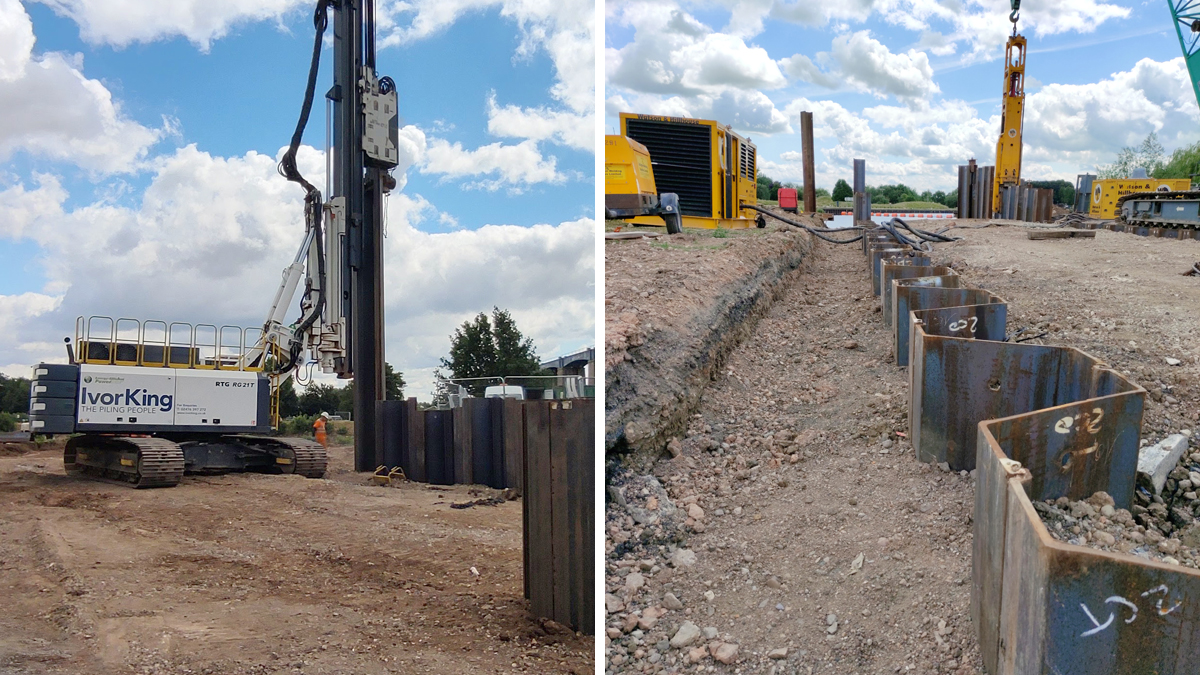
(left) Piling rig and (right) upstream cofferdam piling run – Courtesy Jackson Civil Engineering
Environmental impact
The completed project will provide a major biodiversity enhancement to the Trent Valley area, and Jackson Civil Engineering has worked to ensure that disruption is kept to a minimum throughout the construction phase.
The removed trees were distributed between local nature projects for footpath protection, outdoor activity centre for use during children’s shelter building experiences, and biomass energy recovery. In addition, the EA will be planting new trees at a ratio of 5:1 within the city of Nottingham region; this is upwards of 1000 new trees.
The project re-utilised hardcore crush material from a locally completed Jackson Civil Engineering project and imported over 3000t of Type 1 and 6F2 for use in the temporary works of the crane and piling platforms.
Significant planning has gone into ensuring that the short ‘in river’ works period (June to September) can be maximised for the dredging works and piling installation. To ensure that the river remains unpolluted, the work areas are encircled with silt mitigation measures and a regime of periodic turbidity and dissolved oxygen testing upstream, downstream and at the work face to ensure there is no deterioration to the river.
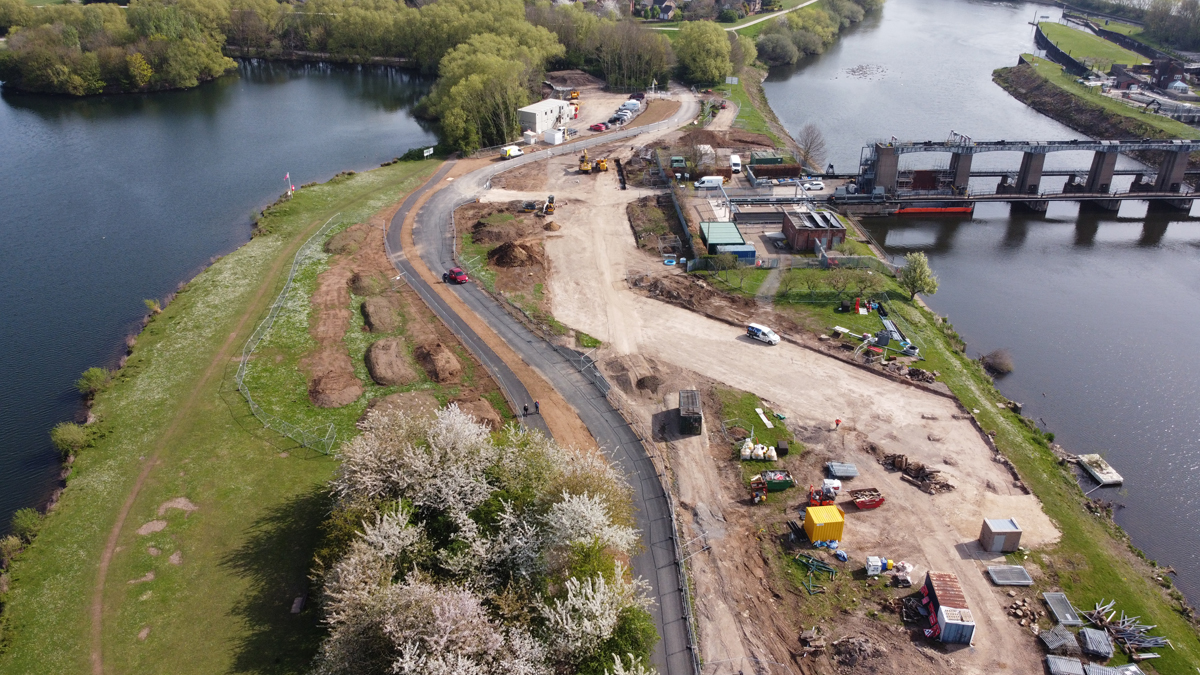
Holme Sluice Area (April 2022) – Courtesy Environment agency
The work continues….
The next few months will see the completion of the piling works, and commencement of the river dredging works, piling capping beams and full excavation of the main channel. The formwork reinforced concrete works are due to commence around the end of October with full MEICA fit out and commissioning in May 2023. Completion of the project is due by July 2023.





